Principle and Recent Development in Photonic Time-Stretch Imaging
Abstract
1. Introduction
2. Principles and Key Components
3. Applications
3.1. Shorter Wavelength Band for PTS Imaging
3.2. Fast Speed for PTS Imaging
3.3. Data Compression for PTS Imaging
3.4. Deep Learning for PTS Imaging
4. Discussion
5. Conclusions
Author Contributions
Funding
Institutional Review Board Statement
Informed Consent Statement
Data Availability Statement
Conflicts of Interest
References
- Xu, J.; Wei, X.; Yu, L.; Zhang, C.; Xu, J.; Wong, K.K.Y.; Tsia, K.K. High-performance multi-megahertz optical coherence tomography based on amplified optical time-stretch. Biomed. Opt. Express 2015, 6, 1340–1350. [Google Scholar] [CrossRef] [PubMed]
- Moon, Q.; Kim, D. Ultra-high-speed optical coherence tomography with a stretched pulse supercontinuum source. Opt. Express 2006, 14, 11575–11584. [Google Scholar] [CrossRef] [PubMed]
- Goda, K.; Fard, A.; Malik, O.; Fu, G.; Quach, A.; Jalali, B. High-throughput optical coherence tomography at 800 nm. Opt. Express 2012, 20, 19612–19617. [Google Scholar] [CrossRef]
- Xu, J.; Zhang, C.; Xu, J.; Wong, K.K.Y.; Tsia, K.K. Megahertz all-optical swept-source optical coherence tomography based on broadband amplified optical time-stretch. Opt. Lett. 2014, 39, 622–625. [Google Scholar] [CrossRef]
- Larin, K.; Sampson, D. Optical coherence elastography–OCT at work in tissue biomechanics. Biomed. Opt. Express 2017, 8, 1172–1202. [Google Scholar] [CrossRef]
- Klein, T.; Huber, R. High-speed OCT light sources and systems. Biomed. Opt. Express 2017, 8, 828–859. [Google Scholar] [CrossRef]
- Marques, M.; Bradu, A.; Podoleanu, A. Towards simultaneous Talbot bands based optical coherence tomography and scanning laser ophthalmoscopy imaging. Opt. Express 2014, 5, 1428–1444. [Google Scholar] [CrossRef] [PubMed]
- Marques, M.; Rivet, S.; Bradu, A.; Podoleanu, A. Polarization-sensitive optical coherence tomography system tolerant to fiber disturbances using a line camera. Opt. Lett. 2015, 40, 3858–3861. [Google Scholar] [CrossRef]
- Castro, A.; Enríquez, E.; Marcos, S. Effect of fixational eye movements in corneal topography measurements with optical coherence tomography. Biomed. Opt. Express 2023, 14, 2138–2152. [Google Scholar] [CrossRef] [PubMed]
- Mididoddi, C.K.; Bai, F.; Wang, G.; Liu, J.; Gibson, S.; Wang, C. High-Throughput Photonic Time-Stretch Optical Coherence Tomography with Data Compression. IEEE Photonics J. 2017, 9, 3901015. [Google Scholar] [CrossRef]
- Lei, C.; Guo, B.; Cheng, Z.; Goda, K. Optical time-stretch imaging: Principles and applications. Appl. Phys. Rev. 2016, 3, 011102. [Google Scholar] [CrossRef]
- Zhu, Z.; Chi, H.; Jin, T.; Zheng, S.; Jin, X.; Zhang, X. Single-pixel imaging based on compressive sensing with spectral-domain optical mixing. Opt. Commun. 2017, 402, 119–122. [Google Scholar] [CrossRef]
- Guo, Q.; Chen, H.; Weng, Z.; Chen, M.; Yang, S.; Xie, S. Compressive sensing based high-speed time- stretch optical microscopy for two-dimensional image acquisition. Opt. Express 2015, 23, 29639–29646. [Google Scholar] [CrossRef] [PubMed]
- Chen, C.; Mahjoubfar, A.; Jalali, B. Optical Data Compression in Time Stretch Imaging. PLoS ONE 2015, 10, 0125106. [Google Scholar] [CrossRef]
- Mahjoubfar, A.; Chen, C.; Jalali, B. Design of Warped Stretch Transform. Sci. Rep. 2013, 5, 17148. [Google Scholar] [CrossRef]
- Chen, H.; Weng, Z.; Liang, Y.; Lei, C.; Xing, F.; Chen, M.; Xie, S. High speed single-pixel imaging via time domain compressive sampling. In Proceedings of the Conferences, Lasers Electro-Optics, San Jose, CA, USA, 14–9 May 2017. [Google Scholar]
- Guo, Q.; Chen, H.; Wang, Y.; Guo, Y.; Liu, P.; Zhu, X.; Cheng, Z.; Yu, Z.; Yang, S.; Chen, M.; et al. High-Speed Compressive Microscopy of Flowing Cells Using Sinusoidal Illumination Patterns. IEEE Photonics J. 2017, 9, 3900111. [Google Scholar] [CrossRef]
- Matin, A.; Wang, X. Compressive Ultrafast Optical Time-Stretch Imaging. In Proceedings of the 22nd International Conference on Transparent Optical Networks (ICTON), Bari, Italy, 19–23 July 2020. [Google Scholar]
- Yang, S.; Wang, J.; Chi, H.; Yang, B. Distortion compensation in continuous-time photonic time-stretched ADC based on redundancy detection. Appl. Opt. 2021, 60, 1646–1652. [Google Scholar] [CrossRef]
- Pu, G.; Jalali, B. Neural network enabled time stretch spectral regression. Opt. Express 2021, 29, 20786–20794. [Google Scholar] [CrossRef] [PubMed]
- Wang, G.; Zhao, F.; Xiao, D.; Shao, L.; Zhou, Y.; Yu, F.; Wang, W.; Liu, H.; Wang, C.; Min, R.; et al. Highly efficient single-pixel imaging system based on the STEAM structure. Opt. Express 2021, 29, 43203–43211. [Google Scholar] [CrossRef]
- Wang, G.; Zhou, Y.; Zhao, F.; Shao, L.; Liu, H.; Sun, L.; Jiao, S.; Wang, W.; Min, R.; Du, E.; et al. A Compact and Highly Efficient Compressive Sensing Imaging System Using In-Fiber Grating. IEEE Photon. Tech. Lett. 2023, 35, 195–198. [Google Scholar] [CrossRef]
- Chen, C.; Mahjoubfar, A.; Tai, L.; Blaby, I.; Huang, A.; Niazi, K.; Jalali, B. Deep Learning in Label-free Cell Classification. Sci. Rep. 2016, 6, 21471. [Google Scholar] [CrossRef]
- Kobayashi, H.; Lei, C.; Wu, Y.; Mao, A.; Jiang, Y.; Guo, B.; Ozeki, Y.; Goda, K. Label-free detection of cellular drug responses by high-throughput bright-field imaging and machine learning. Sci. Rep. 2017, 7, 12454. [Google Scholar] [CrossRef]
- Lei, C.; Kobayashi, H.; Wu, Y.; Li, M.; Isozaki, A.; Yasumoto, A.; Mikami, H.; Ito, T.; Nitta, N.; Sugimura, T.; et al. High-throughput imaging flow cytometry by optofluidic time-stretch microscopy. Nat. Protoc. 2018, 13, 1603–1631. [Google Scholar] [CrossRef] [PubMed]
- Wang, G.; Yan, Z.; Yang, L.; Zhang, L.; Wang, C. Improved Resolution Optical Time Stretch Imaging Based on High Efficiency In-Fiber Diffraction. Sci. Rep. 2018, 8, 600. [Google Scholar] [CrossRef] [PubMed]
- Wang, G.; Wang, C. Diffraction Limited Optical Time-Stretch Microscopy Using an In-Fibre Diffraction Grating. In Proceedings of the Frontiers in Optics, Rochester, NY, USA, 17–21 October 2016. [Google Scholar]
- Diebold, E.; Buckley, B.; Gossett, D.; Jalali, B. Digitally synthesized beat frequency multiplexing for sub-millisecond fluorescence microscopy. Nat. Photonics 2013, 7, 806–810. [Google Scholar] [CrossRef]
- Wang, G.; Shao, L.; Liu, Y.; Xu, W.; Xiao, D.; Liu, S.; Hu, J.; Zhao, F.; Shum, P.; Wang, W.; et al. Low-cost compressive sensing imaging based on spectrum-encoded time-stretch structure. Opt. Express 2021, 29, 14931–14940. [Google Scholar] [CrossRef]
- Du, E.; Shen, S.; Chong, S.; Chen, N. Multifunctional laser speckle imaging. Biomed. Opt. Express 2020, 11, 2007–2016. [Google Scholar] [CrossRef]
- Du, E.; Shen, S.; Qiu, A.; Chen, N. Line Scan Spatial Speckle Contrast Imaging and Its Application in Blood Flow Imaging. Appl. Sci. 2021, 11, 10969. [Google Scholar] [CrossRef]
- Shen, S.; Du, E.; Zhang, M.; Wen, Y.; Long, K.; Qiu, A.; Chen, N. Confocal rescan structured illumination microscopy for real-time deep tissue imaging with superresolution. Adv. Photon. Nexus 2023, 2, 016009. [Google Scholar] [CrossRef]
- Du, E.; Shen, S.; Qiu, A.; Chen, N. Confocal laser speckle autocorrelation imaging of dynamic flow in microvasculature. Opto-Electron. Adv. 2022, 5, 210045. [Google Scholar] [CrossRef]
- Hashimoto, K.; Nakamura, T.; Kageyama, T.; Badarla, V.; Shimada, H.; Horisaki, R.; Ideguchi, T. Upconversion time-stretch infrared spectroscopy. Light Sci. Appl. 2023, 12, 48. [Google Scholar] [CrossRef] [PubMed]
- Kawai, A.; Hashimoto, K.; Dougakiuchi, T.; Badarla, V.; Imamura, T.; Edamura, T.; Ideguchi, T. Time-stretch infrared spectroscopy. Commun. Phys. 2020, 3, 152. [Google Scholar] [CrossRef]
- Zeng, J.; Sander, M. Real-time observation of chaotic and periodic explosions in a mode-locked Tm-doped fiber laser. Opt. Express 2022, 30, 7894–7906. [Google Scholar] [CrossRef] [PubMed]
- Fordell, T. Real-time optical time interpolation using spectral interferometry. Opt. Lett. 2022, 47, 1194–1197. [Google Scholar] [CrossRef]
- Yang, B.; Ma, Z.; Yang, S.; Chi, H. Broadband and linearized photonic time-stretch analog-to-digital converter based on a compact dual-polarization modulator. Appl. Opt. 2023, 62, 921–926. [Google Scholar] [CrossRef]
- Jiang, T.; Wang, L.; Li, J. High-resolution timing jitter measurement based on the photonics time stretch technique. Opt. Express 2023, 31, 6722–6729. [Google Scholar] [CrossRef]
- Huang, B.; Wang, W.; Bates, M.; Zhuang, X. Three-dimensional Super-resolution Imaging by Stochastic Optical Reconstruction Microscopy. Science 2008, 319, 810–813. [Google Scholar] [CrossRef]
- Tam, J.; Merino, D. Stochastic optical reconstruction microscopy (STORM) in comparison with stimulated emission depletion (STED) and other imaging methods. J. Neurochem. 2015, 135, 643–658. [Google Scholar] [CrossRef]
- Thompson, S.; Jorns, M.; Pappas, D. Synthesis and Characterization of Dye-Doped Au@SiO2 Core-Shell Nanoparticles for Super-Resolution Fluorescence Microscopy. Appl. Spectrosc. 2022, 76, 1367–1374. [Google Scholar] [CrossRef]
- Kaderuppan, S.; Wong, E.; Sharma, A.; Woo, W. Smart Nanoscopy: A Review of Computational Approaches to Achieve Super-Resolved Optical Microscopy. IEEE Access 2020, 8, 214801–214831. [Google Scholar] [CrossRef]
- Lee, S.; Shin, J.; Lee, A.; Bustamante, C. Counting single photoactivatable fluorescent molecules by photoactivated localization microscopy (PALM). Proc. Natl. Acad. Sci. USA 2012, 109, 17436–17441. [Google Scholar] [CrossRef] [PubMed]
- Lelek, M.; Gyparaki, M.T.; Beliu, G.; Schueder, F.; Griffié, J.; Manley, S.; Jungmann, R.; Sauer, M.; Lakadamyali, M.; Zimmer, C. Single-molecule localization microscopy. Nat. Rev. Methods Prim. 2021, 1, 39. [Google Scholar] [CrossRef] [PubMed]
- Zhang, S.; Chen, D.; Niu, H. 3D localization of high particle density images using sparse recovery. Appl. Opt. 2015, 54, 7859–7864. [Google Scholar] [CrossRef] [PubMed]
- Leung, B.; Chou, K. Review of super-resolution fluorescence microscopy for biology. Appl. Spectrosc. 2011, 65, 967–980. [Google Scholar] [CrossRef] [PubMed]
- Hirvonen, L.M.; Wicker, K.; Mandula, O.; Heintzmann, R. Structured illumination microscopy of a living cell. Eur. Biophys. J. 2009, 38, 807–812. [Google Scholar] [CrossRef] [PubMed]
- Linares, A.; Brighi, C.; Espinola, S.; Bacchi, F.; Crevenna, Á.H. Structured Illumination Microscopy Improves Spot Detection Performance in Spatial Transcriptomics. Cells 2023, 12, 1310. [Google Scholar] [CrossRef]
- Poole, J.J.A.; Mostaço-Guidolin, L.B. Optical Microscopy and the Extracellular Matrix Structure: A Review. Cells 2021, 10, 1760. [Google Scholar] [CrossRef] [PubMed]
- Kim, Y.; So, P. Three-dimensional wide-field pump-probe structured illumination microscopy. Opt. Express 2017, 25, 7369–7391. [Google Scholar] [CrossRef]
- Butola, A.; Acuna, S.; Hansen, D.; Agarwal, K. Scalable-resolution structured illumination microscopy. Opt. Express 2022, 30, 43752–43767. [Google Scholar] [CrossRef]
- Burns, Z.; Liu, Z. Untrained, physics-informed neural networks for structured illumination microscopy. Opt. Express 2023, 31, 8714–8724. [Google Scholar] [CrossRef]
- Wang, Y.; Yang, Q.; Shou, Y.; Luo, H. Optical analog computing enabled broadband structured light. Opt. Lett. 2023, 48, 2014–2017. [Google Scholar] [CrossRef] [PubMed]
- Vicidomini, G.; Bianchini, P.; Diaspro, A. STED super-resolved microscopy. Nat. Methods 2018, 15, 173–182. [Google Scholar] [CrossRef] [PubMed]
- Hell, S. Far-Field Optical Nanoscopy. Science 2007, 316, 1153–1158. [Google Scholar] [CrossRef]
- Gao, L.; Liang, J.; Li, C.; Wang, L. Single-shot compressed ultrafast photography at one hundred billion frames per second. Nature 2014, 516, 74–77. [Google Scholar] [CrossRef] [PubMed]
- Mishra, Y.N.; Wang, P.; Bauer, F.J.; Zhang, Y.; Hanstorp, D.; Will, S.; Wang, L. Single-pulse real-time billion-frames-per-second planar imaging of ultrafast nanoparticle-laser dynamics and temperature in flames. Light Sci. Appl. 2023, 12, 47. [Google Scholar] [CrossRef]
- Goda, K.; Tsia, K.; Jalali, B. Serial time-encoded amplified imaging for real-time observation of fast dynamic phenomena. Nature 2009, 458, 1145–1149. [Google Scholar] [CrossRef] [PubMed]
- Michel, J.; Liu, J.; Kimerling, L. High-performance Ge-on-Si photodetectors. Nat. Photonics 2010, 4, 527–534. [Google Scholar] [CrossRef]
- Konstantatos, G.; Sargent, E. Nanostructured materials for photon detection. Nat. Nanotechnol. 2010, 5, 391–400. [Google Scholar] [CrossRef]
- Le Roux, L.G.; Qiu, X.; Jacobsen, M.C.; Pagel, M.D.; Gammon, S.T.; Piwnica-Worms, D.R.; Schellingerhout, D. Axonal Transport as an In Vivo Biomarker for Retinal Neuropathy. Cells 2020, 9, 1298. [Google Scholar] [CrossRef]
- Yap, T.E.; Donna, P.; Almonte, M.T.; Cordeiro, M.F. Real-Time Imaging of Retinal Ganglion Cell Apoptosis. Cells 2018, 7, 60. [Google Scholar] [CrossRef]
- Denk, W.; Strickler, J.; Webb, W. Two-Photon Laser Scanning Fluorescence Microscopy. Science 1990, 248, 73–76. [Google Scholar] [CrossRef] [PubMed]
- vom Werth, K.L.; Kemper, B.; Kampmeier, S.; Mellmann, A. Application of Digital Holographic Microscopy to Analyze Changes in T-Cell Morphology in Response to Bacterial Challenge. Cells 2023, 12, 762. [Google Scholar] [CrossRef] [PubMed]
- Zhang, C.; Fu, J.; Zhao, G. Learning from Projection to Reconstruction: A Deep Learning Reconstruction Framework for Sparse-View Phase Contrast Computed Tomography via Dual-Domain Enhancement. Appl. Sci. 2023, 13, 6051. [Google Scholar] [CrossRef]
- Xie, Z.; Zhang, W.; Wang, L.; Zhou, J.; Li, Z. Optical and SAR Image Registration Based on the Phase Congruency Framework. Appl. Sci. 2023, 13, 5887. [Google Scholar] [CrossRef]
- Wei, X.; Kong, C.; Sy, S.; Ko, H.; Tsia, K.K.; Wong, K.K.Y. Ultrafast time-stretch imaging at 932 nm through a new highly-dispersive fiber. Biomed. Opt. Express 2016, 7, 5208–5217. [Google Scholar] [CrossRef]
- Wu, J.; Tang, A.H.L.; Wong, K.K.Y.; Tsia, K.K. Optical time-stretch microscopy at visible wavelengths. In Proceedings of the Frontiers in Optics, Rochester, NY, USA, 17–21 October 2016. [Google Scholar]
- Wu, J.; Xu, Y.; Xu, J.; Wei, X.; Chan, A.C.S.; Tang, A.H.L.; Lau, A.K.S.; Chung, B.M.F.; Shum, H.; Lam, E.Y.; et al. Ultrafast laser-scanning time-stretch imaging at visible wavelengths. Light Sci. Appl. 2017, 6, e16196. [Google Scholar] [CrossRef]
- Wei, X.; Lau, A.K.S.; Wong, T.T.W.; Zhang, C.; Tsia, K.M.; Wong, K.K.Y. Coherent Laser Source for High Frame-Rate Optical Time-Stretch Microscopy at 1.0 μm. IEEE J. Sel. Top. Quantum Electron. 2014, 20, 384–389. [Google Scholar] [CrossRef]
- Lau, A.K.S.; Wong, T.T.W.; Ho, K.K.Y.; Tang, M.T.H.; Chan, A.C.S.; Wei, X.; Lam, E.Y.; Shum, H.C.; Wong, K.K.Y.; Tsia, K.K. Interferometric time-stretch microscopy for ultrafast quantitative cellular and tissue imaging at 1 μm. J. Biomed. Opt. 2014, 19, 076001. [Google Scholar] [CrossRef]
- Wong, T.T.W.; Lau, A.K.S.; Wong, K.K.Y.; Tsia, K.K. Optical time-stretch confocal microscopy at 1 μm. Opt. Lett. 2012, 37, 3330–3332. [Google Scholar] [CrossRef]
- Xing, F.; Chen, H.; Lei, C.; Weng, Z.; Chen, M.; Yang, S.; Xie, S. Serial wavelength division 1 GHz line-scan microscopic imaging. Photon. Res. 2014, 2, B31–B34. [Google Scholar] [CrossRef]
- Chi, H.; Zhu, Z. Analytical Model for Photonic Compressive Sensing with Pulse Stretch and Compression. IEEE Photonics J. 2019, 11, 5500410. [Google Scholar] [CrossRef]
- Lei, C.; Wu, Y.; Sankaranarayanan, A.C.; Chang, S.; Guo, B.; Sasaki, N.; Kobayashi, H.; Sun, C.; Ozeki, Y.; Goda, K. GHz Optical Time-Stretch Microscopy by Compressive Sensing. IEEE Photonics J. 2017, 9, 3900308. [Google Scholar] [CrossRef]
- Asghari, M.H.; Jalali, B. Warped time lens in temporal imaging for optical real-time data compression. Chin. Sci. Bull. 2014, 59, 2649–2654. [Google Scholar] [CrossRef]
- Wang, G.; Xiao, D.; Shao, L.; Zhao, F.; Hu, J.; Liu, S.; Liu, H.; Wang, C.; Min, R.; Yan, Z. An Undersampling Communication System Based on Compressive Sensing and In-fiber Grating. IEEE Photonics J. 2021, 13, 7300507. [Google Scholar] [CrossRef]
- Goda, K.; Tsia, K.K.; Jalali, B. Amplified dispersive Fourier-transform imaging for ultrafast displacement sensing and barcode reading. Appl. Phys. Lett. 2008, 93, 131109. [Google Scholar] [CrossRef]
- Kim, S.; Goda, K.; Fard, A.; Jalali, B. Optical time-domain analog pattern correlator for high-speed real-time image recognition. Opt. Lett. 2011, 36, 220–222. [Google Scholar] [CrossRef]
- Fard, A.; Mahjoubfar, A.; Goda, K.; Gossett, D.; Carlo, D.; Jalali, B. Nomarski serial time-encoded amplified microscopy for high-speed contrast-enhanced imaging of transparent media. Biomed. Opt. Express 2011, 2, 3387–3392. [Google Scholar] [CrossRef]
- Fossum, E. CMOS image sensors: Electronic camera-on-a-chip. IEEE Trans. Electron. Devices 1997, 44, 1689–1698. [Google Scholar] [CrossRef]
- Görg, A.; Weiss, W.; Dunn, M. Current two-dimensional electrophoresis technology for proteomics. Proteomics 2004, 4, 3665–3685. [Google Scholar] [CrossRef] [PubMed]
- Baker, M. Faster frames, clearer pictures. Nat. Methods 2011, 8, 1005–1009. [Google Scholar] [CrossRef]
- Tiwari, V.; Sutton, M.; McNeill, S. Assessment of High Speed Imaging Systems for 2D and 3D Deformation Measurements: Methodology Development and Validation. Exp. Mech. 2007, 47, 561–579. [Google Scholar] [CrossRef]
- Honda, H.; Iida, Y.; Egawa, Y.; Seki, H. A Color CMOS Imager with 4 × 4 White-RGB Color Filter Array for Increased Low-Illumination Signal-to-Noise Ratio. IEEE Trans. Electron. Devices 2009, 56, 2398–2402. [Google Scholar] [CrossRef]
- Grewe, B.; Langer, D.; Kasper, H.; Kasper, H.; Helmchen, F. High-speed in vivo calcium imaging reveals neuronal network activity with near-millisecond precision. Nat. Methods 2010, 7, 399–405. [Google Scholar] [CrossRef]
- Cundiff, S.; Weiner, A. Optical arbitrary waveform generation. Nat. Photonics 2010, 4, 760–766. [Google Scholar] [CrossRef]
- Xiao, S.; Weiner, M. 2-D wavelength demultiplexer with potential for ≥ 1000 channels in the C-band. Opt. Express 2004, 12, 2895–2902. [Google Scholar] [CrossRef] [PubMed]
- Xiao, S.; Weiner, A.W. An Eight-Channel Hyperfine Wavelength Demultiplexer Using a Virtually Imaged Phased-Array (VIPA). IEEE Photonics Technol. Lett. 2005, 17, 372–375. [Google Scholar] [CrossRef]
- Shirasaki, M. Chromatic-dispersion compensator using virtually imaged phased array. IEEE Photonics Technol. Lett. 1997, 9, 1598–1600. [Google Scholar] [CrossRef]
- Shirasaki, M. Large angular dispersion by a virtually imaged phased array and its application to a wavelength demultiplexer. Opt. Lett. 1996, 21, 366–368. [Google Scholar] [CrossRef]
- Wang, G.; Shao, L.; Xiao, D.; Bandyopadhyay, S.; Jiang, J.; Liu, S.; Li, W.; Wang, C.; Yan, Z. Stable and Highly Efficient Free-Space Optical Wireless Communication System Based on Polarization Modulation and In-Fiber Diffraction. J. Light. Technol. 2021, 39, 83–90. [Google Scholar] [CrossRef]
- Goda, K.; Jalali, B. Dispersive Fourier transformation for fast continuous single-shot measurements. Nat. Photonics 2013, 7, 102–112. [Google Scholar] [CrossRef]
- Chou, J.; Solli, D.; Jalali, B. Real-time spectroscopy with subgigahertz resolution using amplified dispersive Fourier transformation. Appl. Phys. Lett. 2008, 92, 111102. [Google Scholar] [CrossRef]
- Wang, C.; Yao, J. Photonic Generation of Chirped Millimeter-Wave Pulses Based on Nonlinear Frequency-to-Time Mapping in a Nonlinearly Chirped Fiber Bragg Grating. IEEE Trans. Microw. Theory Tech. 2008, 56, 542–553. [Google Scholar] [CrossRef]
- Wang, C.; Yao, J. Chirped Microwave Pulse Generation Based on Optical Spectral Shaping and Wavelength-to-Time Mapping Using a Sagnac Loop Mirror Incorporating a Chirped Fiber Bragg Grating. J. Light. Technol. 2009, 27, 3336–3341. [Google Scholar] [CrossRef]
- Qiu, Y.; Xu, J.; Wong, K.; Tsia, K.K. Exploiting few mode-fibers for optical time-stretch confocal microscopy in the short near-infrared window. Opt. Express 2012, 20, 24115–24123. [Google Scholar] [CrossRef] [PubMed]
- Abramova, V.; Lukin, V.; Abramov, S.; Kryvenko, S.; Lech, P.; Okarma, K. A Fast and Accurate Prediction of Distortions in DCT-Based Lossy Image Compression. Electronics 2023, 12, 2347. [Google Scholar] [CrossRef]
- Peng, Z.; Liu, J. Bistatic Sea Clutter Suppression Method Based on Compressed Sensing Optimization. Appl. Sci. 2023, 13, 6310. [Google Scholar] [CrossRef]
- Zhang, Y.; Chen, X.; Zeng, C.; Gao, K.; Li, S. Compressed Imaging Reconstruction Based on Block Compressed Sensing with Conjugate Gradient Smoothed l0 Norm. Sensors 2023, 23, 4870. [Google Scholar] [CrossRef] [PubMed]
- Xu, M.; Wang, C.; Shi, H.; Fu, Q.; Li, Y.; Dong, L.; Jiang, H. Deep Compressed Super-Resolution Imaging with DMD Alignment Error Correction. Photonics 2023, 10, 581. [Google Scholar] [CrossRef]
- Haleem, A.; Javaid, M.; Singh, R. An era of ChatGPT as a significant futuristic support tool: A study on features, abilities, and challenges. BenchCouncil Trans. Benchmarks Stand. Eval. 2022, 2, 100089. [Google Scholar] [CrossRef]
- Novack, A.; Gould, M.; Yang, Y.; Xuan, Z.; Streshinsky, M.; Liu, Y.; Capellini, G.; Lim, A.; Lo, G.; Baehr-Jones, T.; et al. Germanium photodetector with 60 GHz bandwidth using inductive gain peaking. Opt. Express 2013, 21, 28387–28393. [Google Scholar] [CrossRef]
- Lian, Y.; Tian, W.; Sun, H.; Yu, Y.; Su, Y.; Tong, H.; Zhu, J.; Wei, Z. High–Efficiency, Widely Tunable MgO: PPLN Optical Parametric Oscillator. Photonics 2023, 10, 505. [Google Scholar] [CrossRef]
- Wang, Y.; Wang, X.; Sun, M.; Liang, X.; Wei, H.; Fan, W. Arbitrary Time Shaping of Broadband Low-Coherence Light Based on Optical Parametric Amplification. Photonics 2023, 10, 673. [Google Scholar] [CrossRef]
- Tsia, K.K.; Goda, K.; Capewell, D.; Jalali, B. Performance of serial time-encoded amplified microscope. Opt. Express 2010, 18, 10016–10028. [Google Scholar] [CrossRef] [PubMed]

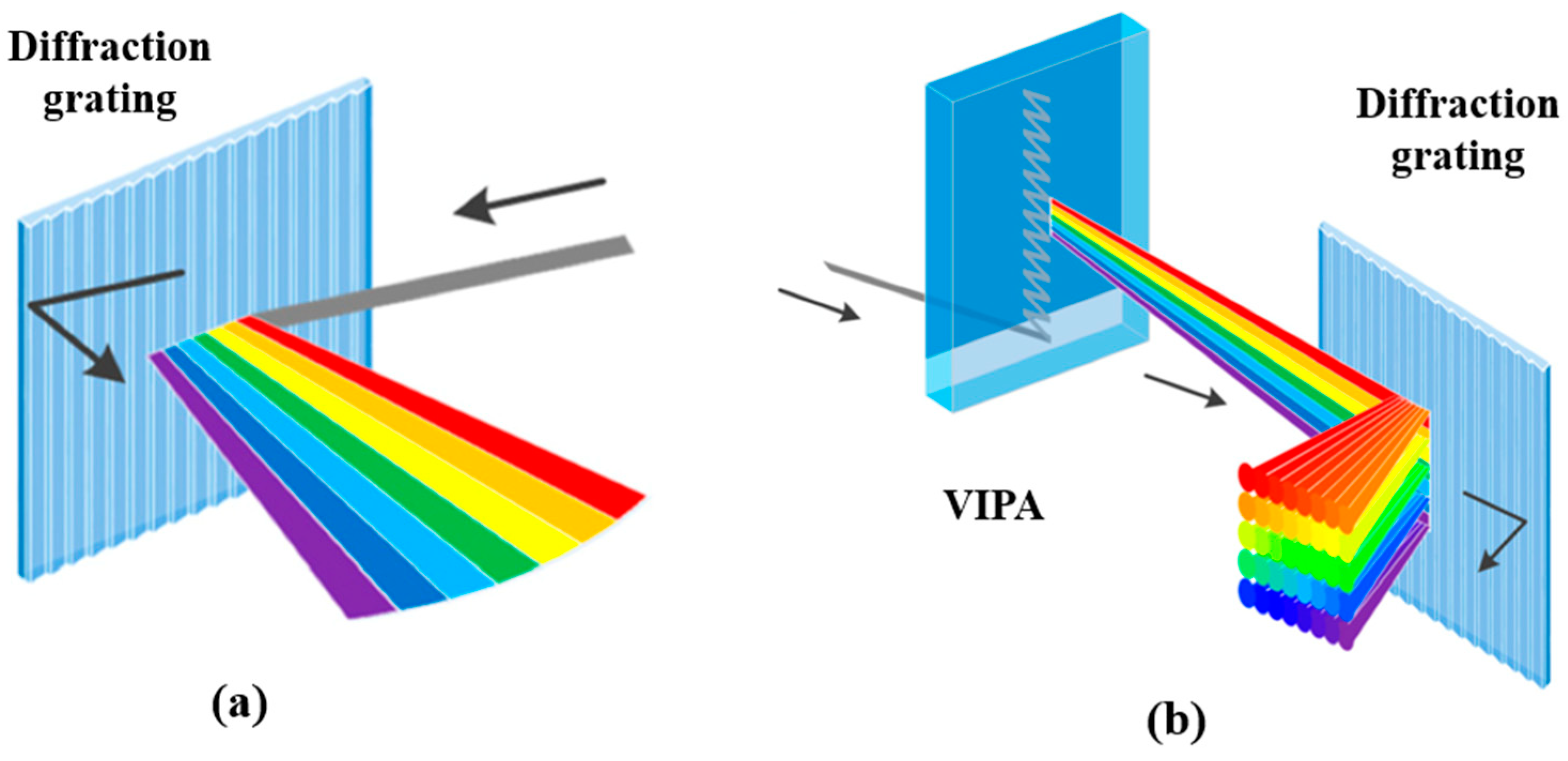
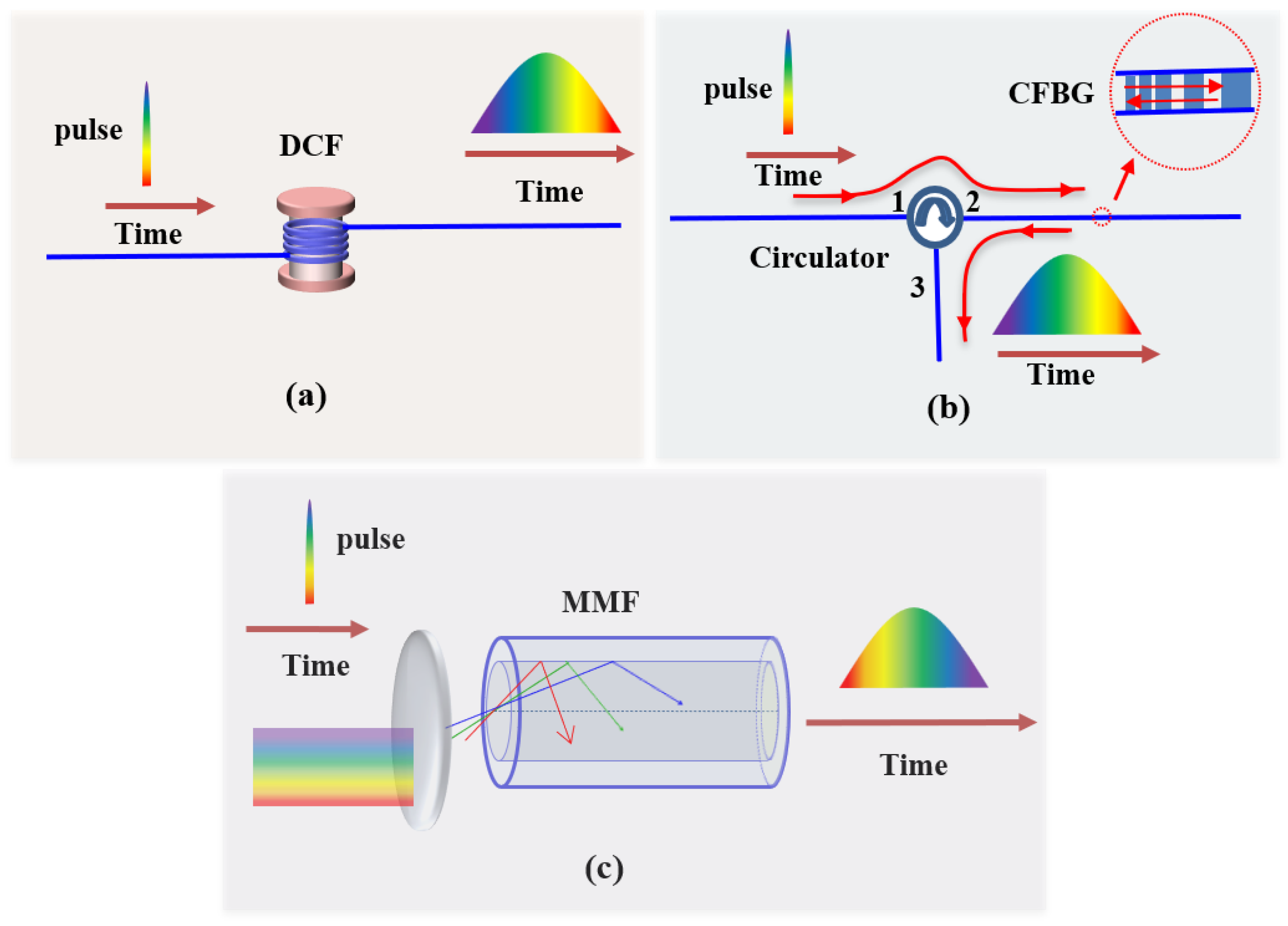
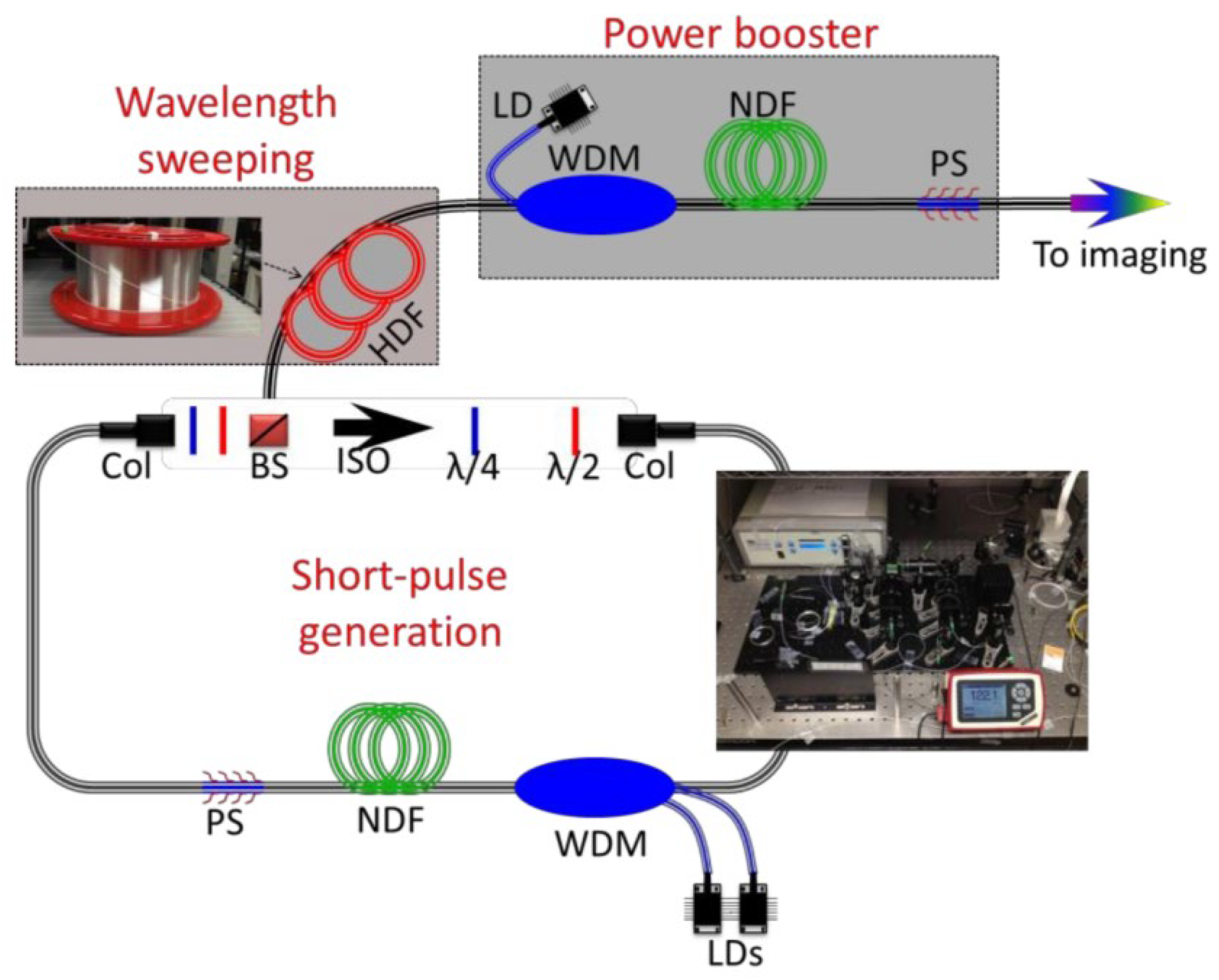


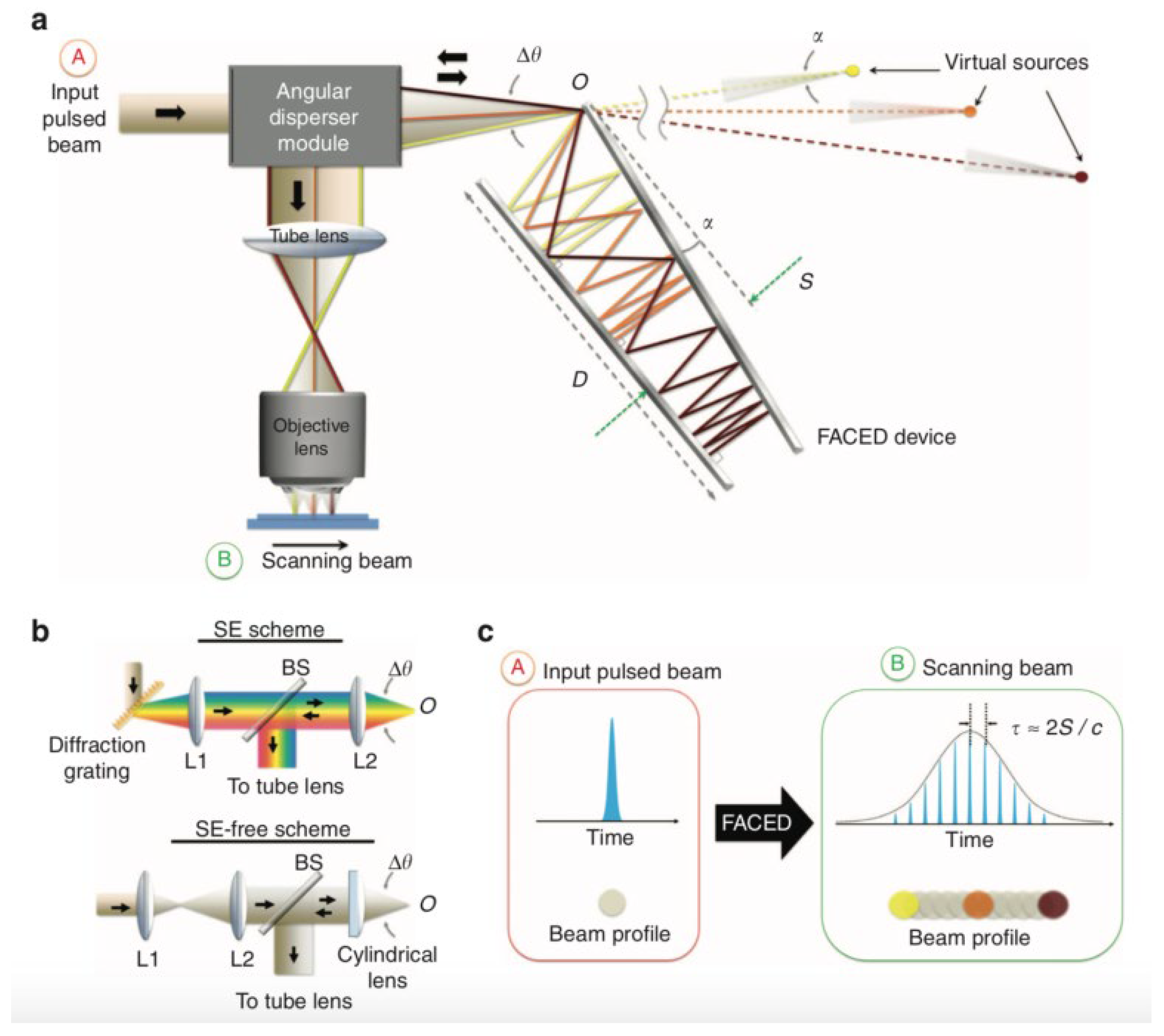
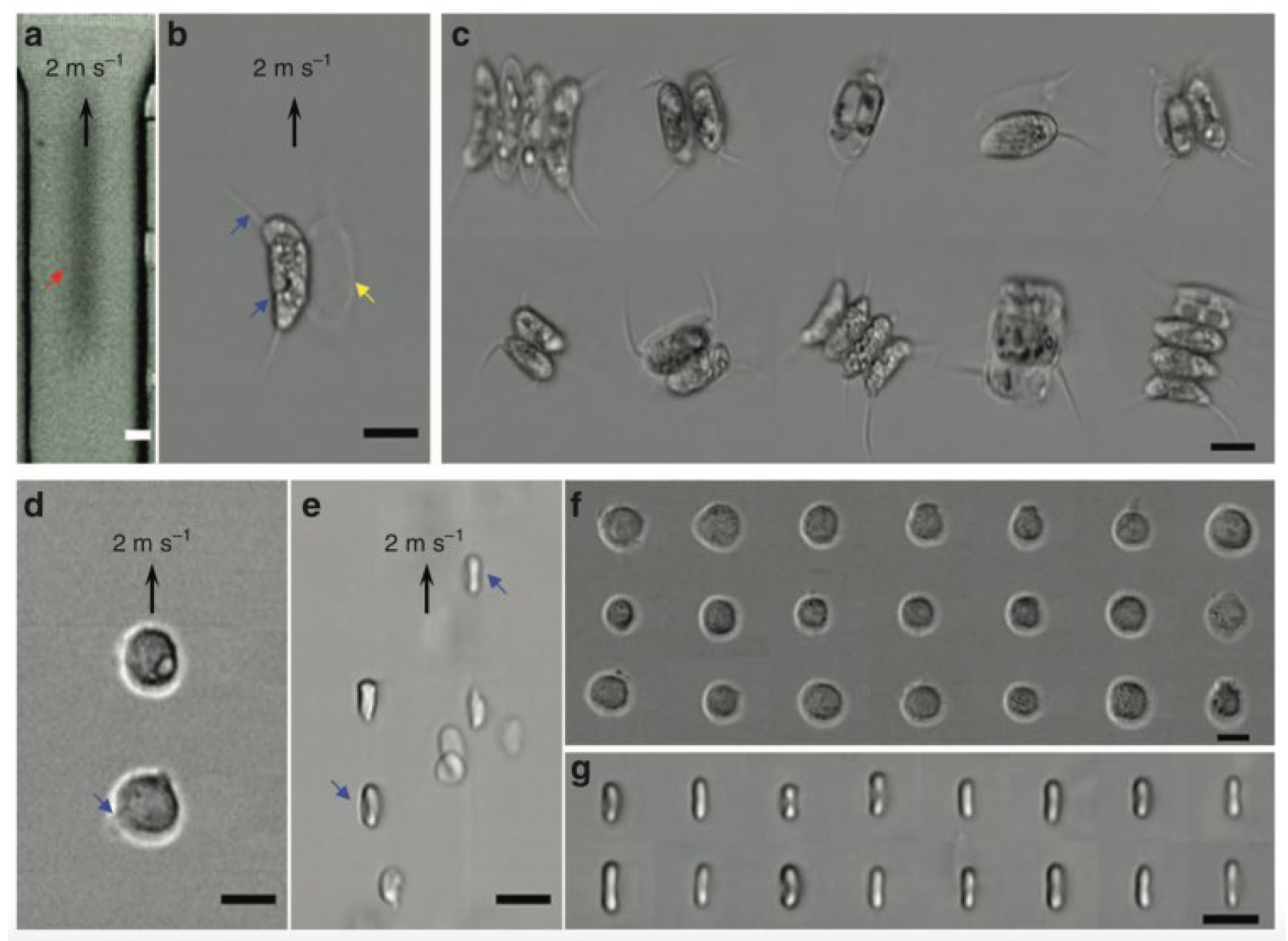
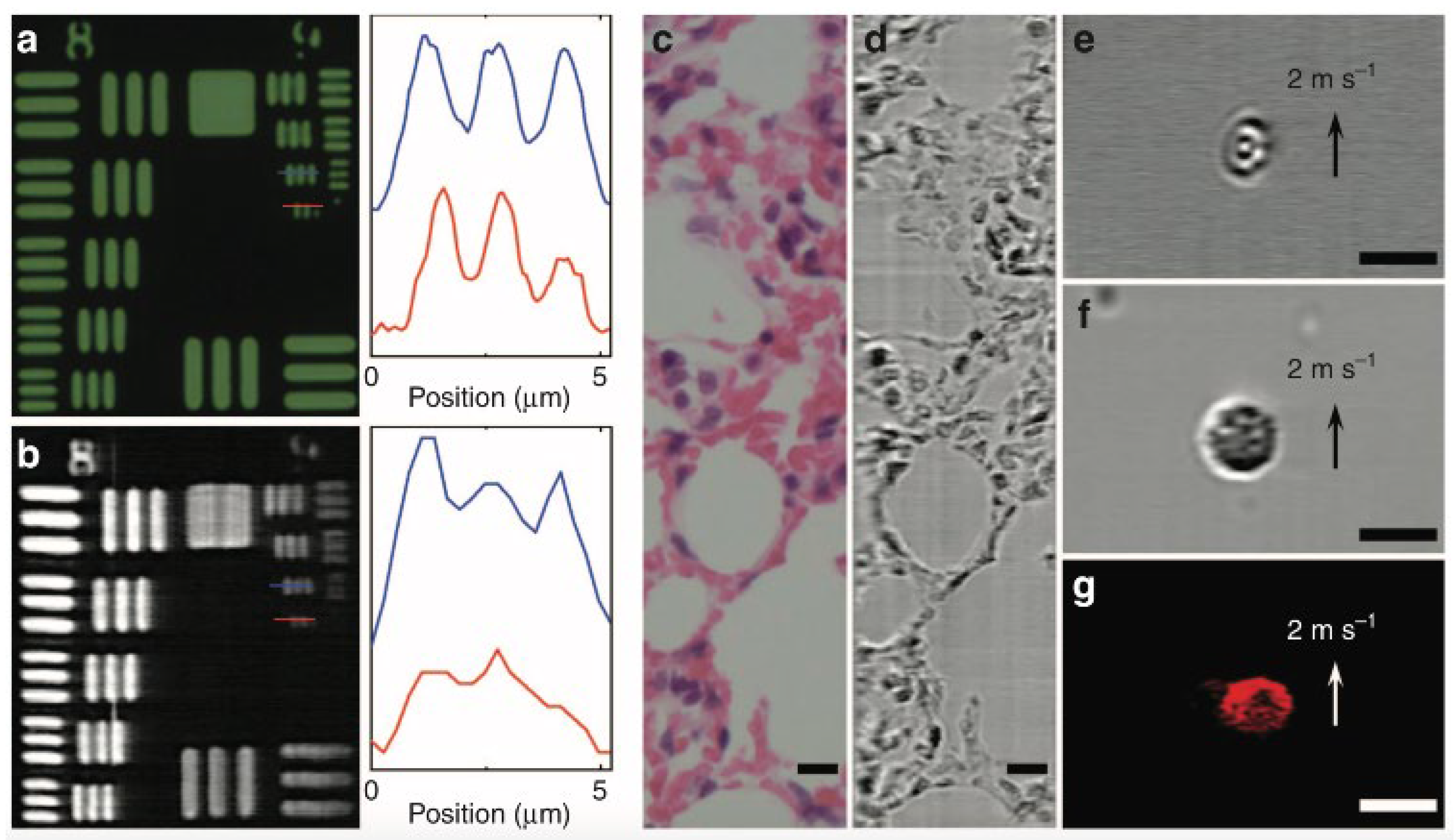
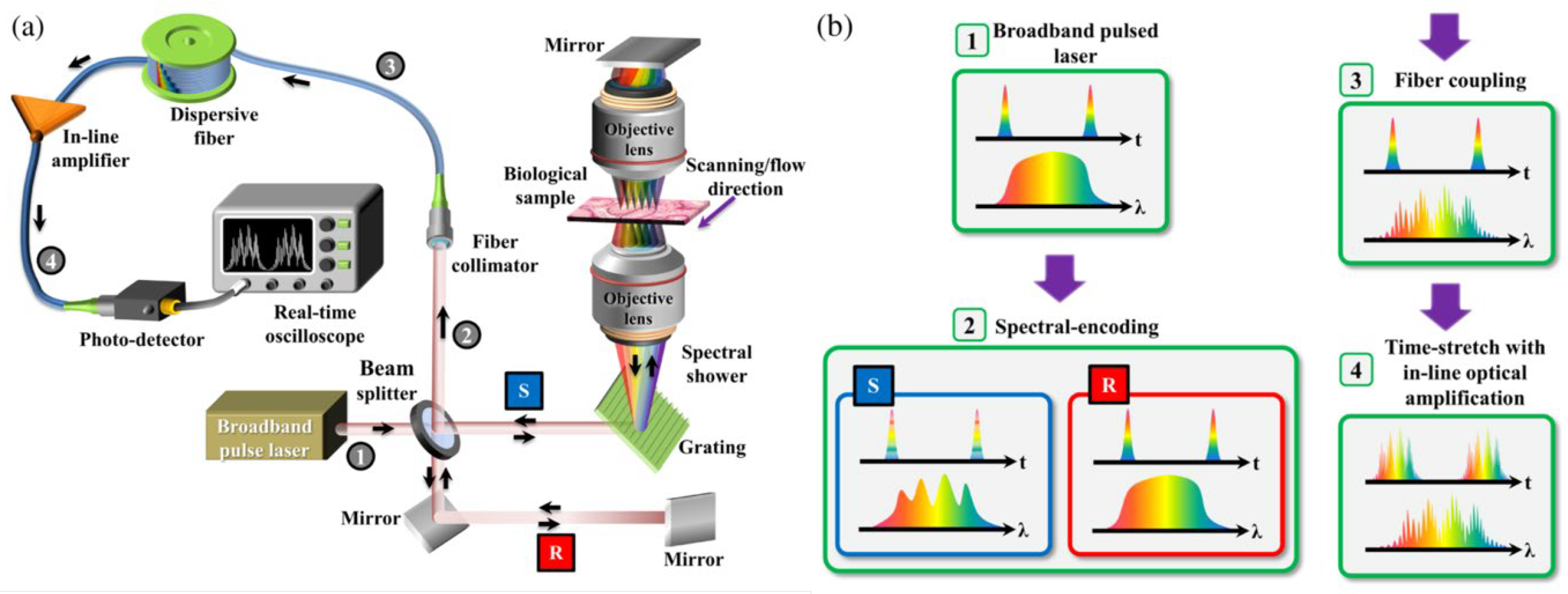
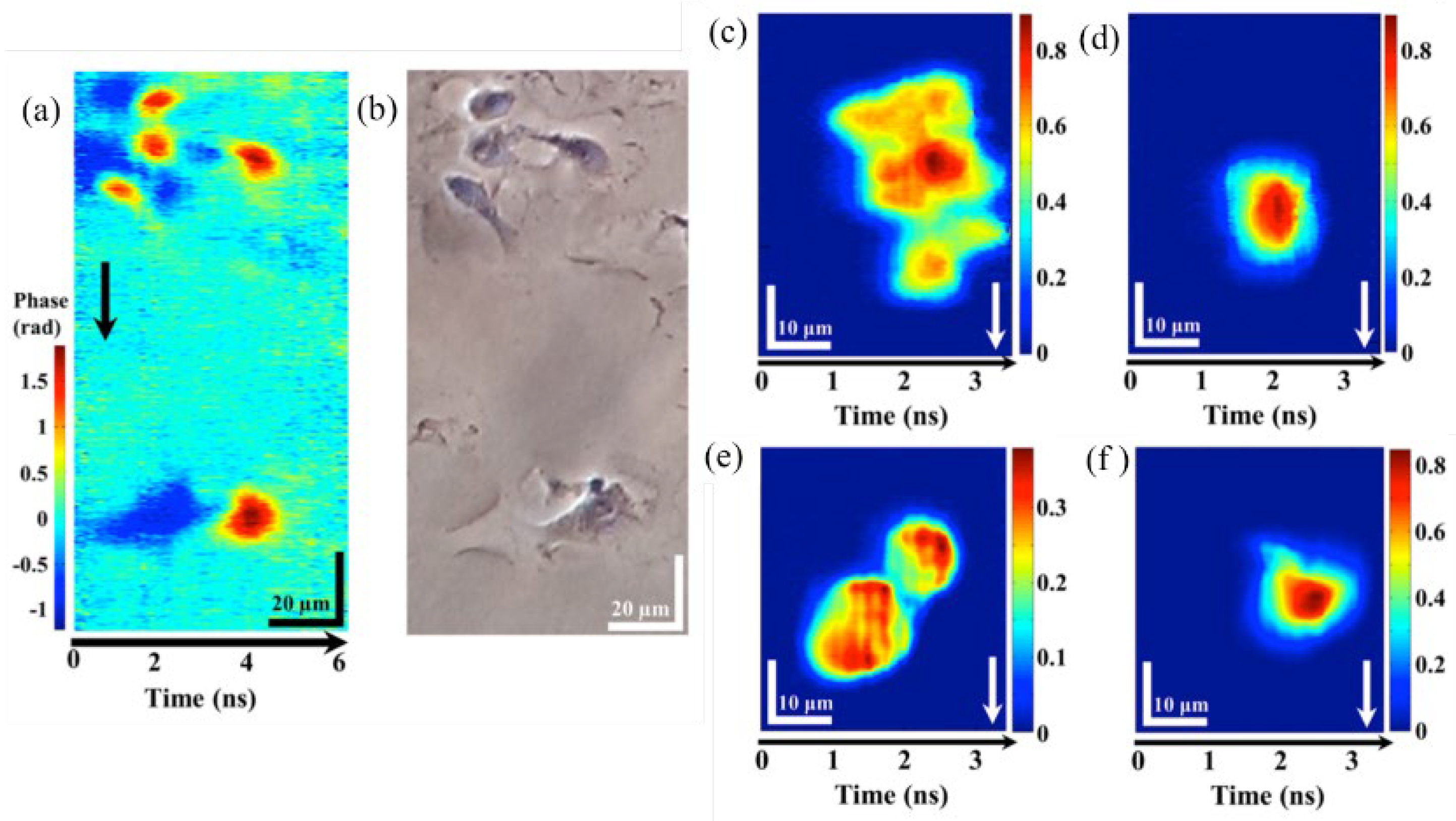
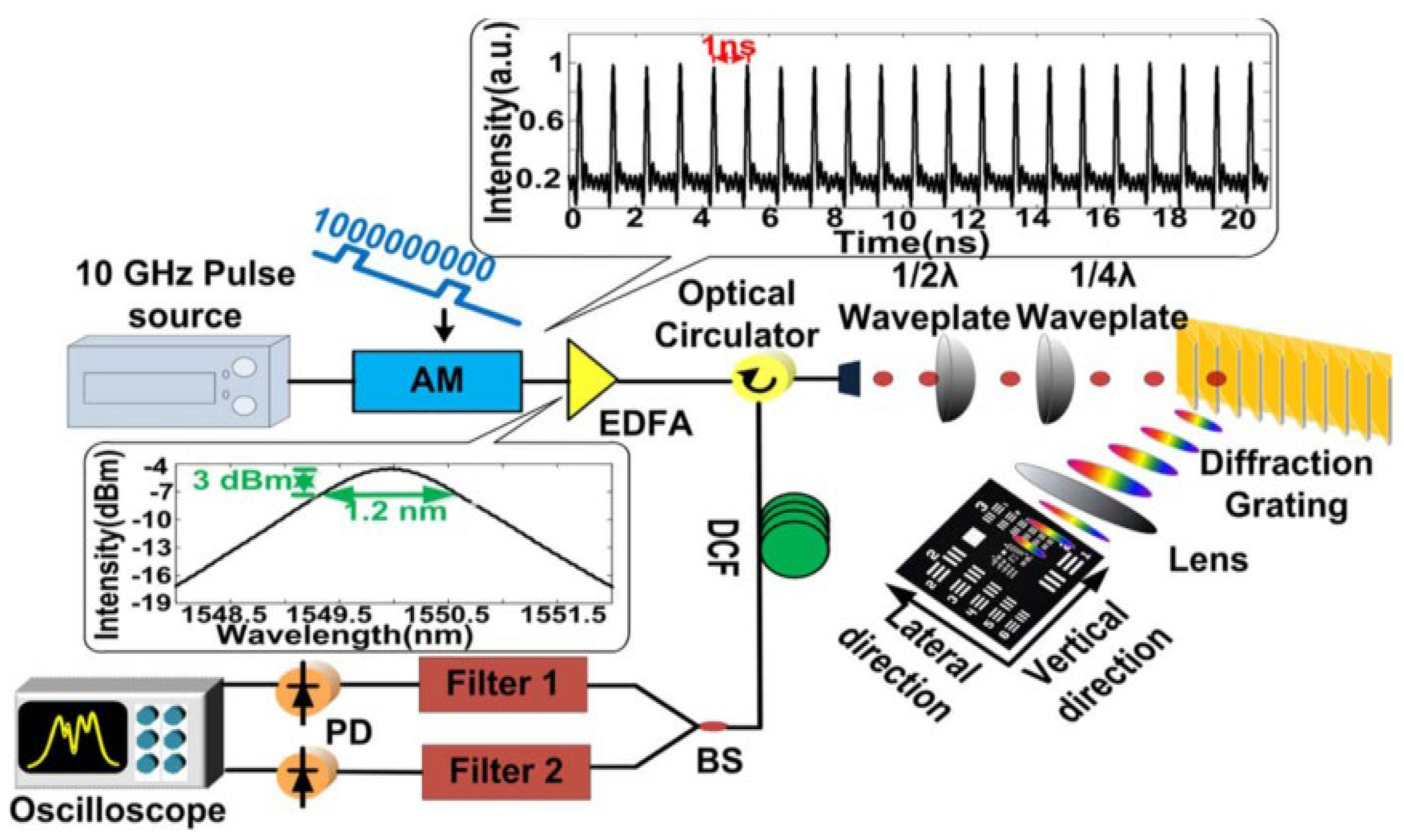


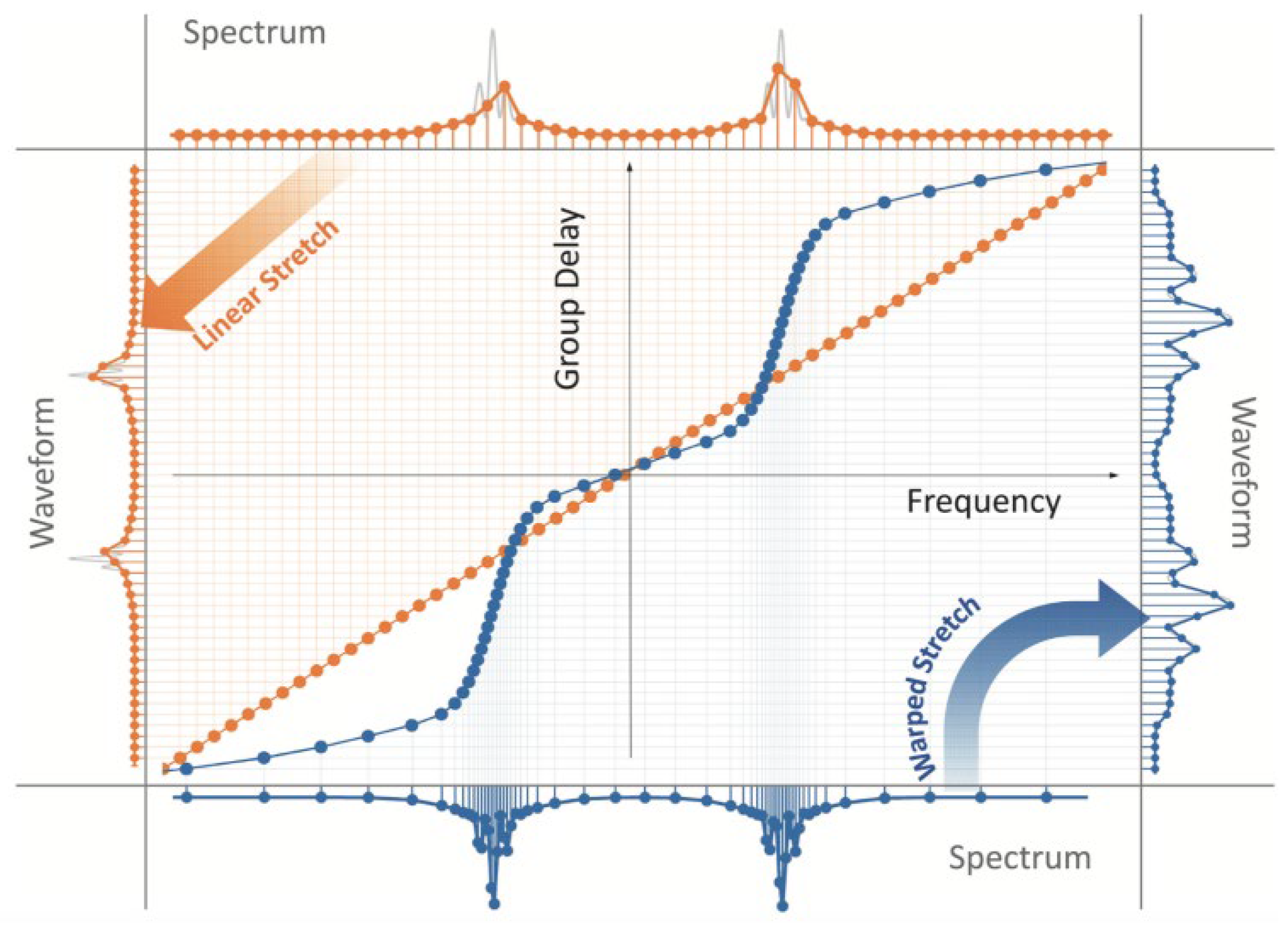

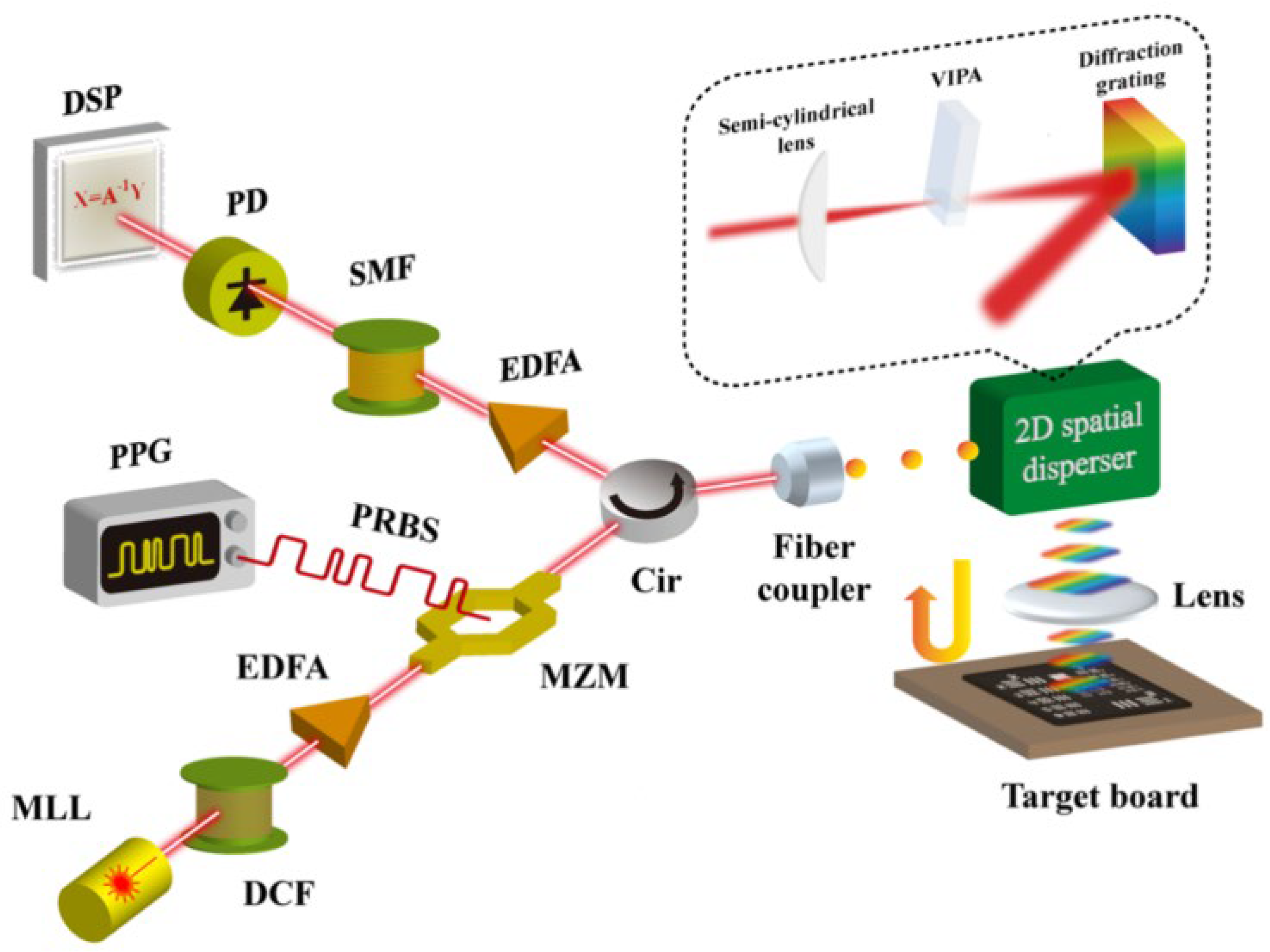
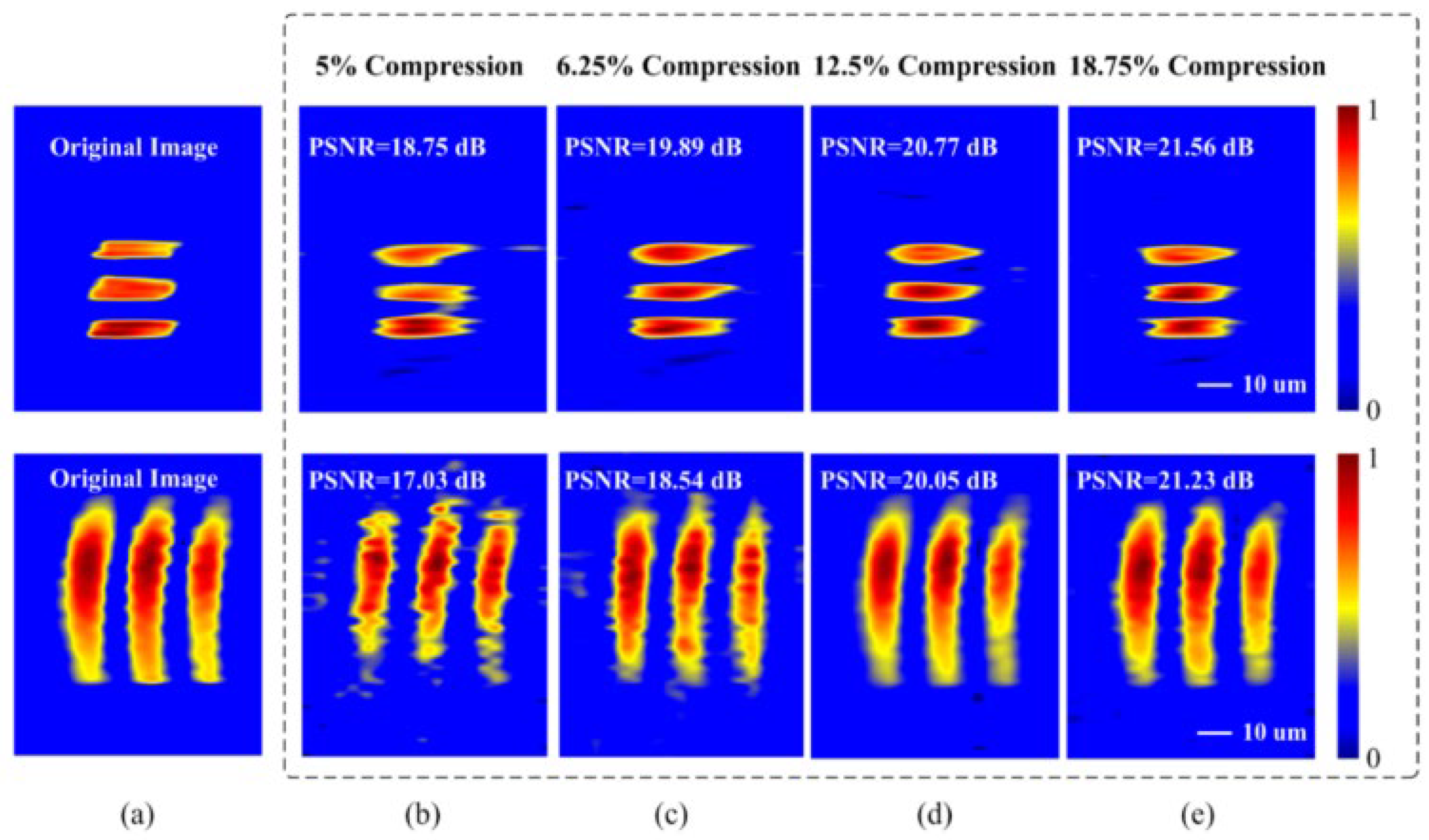
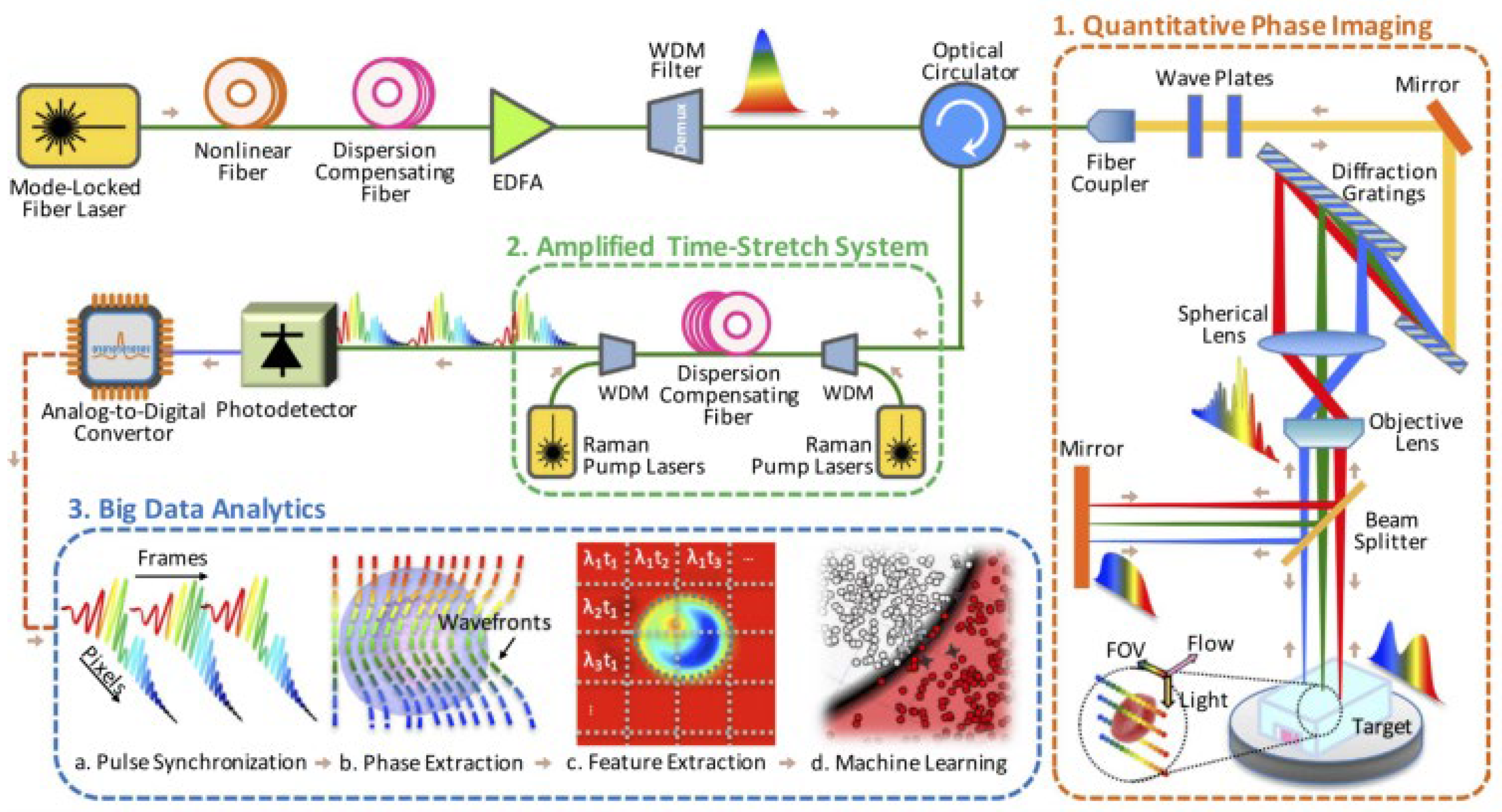

Disclaimer/Publisher’s Note: The statements, opinions and data contained in all publications are solely those of the individual author(s) and contributor(s) and not of MDPI and/or the editor(s). MDPI and/or the editor(s) disclaim responsibility for any injury to people or property resulting from any ideas, methods, instructions or products referred to in the content. |
© 2023 by the authors. Licensee MDPI, Basel, Switzerland. This article is an open access article distributed under the terms and conditions of the Creative Commons Attribution (CC BY) license (https://creativecommons.org/licenses/by/4.0/).
Share and Cite
Wang, G.; Zhou, Y.; Min, R.; Du, E.; Wang, C. Principle and Recent Development in Photonic Time-Stretch Imaging. Photonics 2023, 10, 817. https://doi.org/10.3390/photonics10070817
Wang G, Zhou Y, Min R, Du E, Wang C. Principle and Recent Development in Photonic Time-Stretch Imaging. Photonics. 2023; 10(7):817. https://doi.org/10.3390/photonics10070817
Chicago/Turabian StyleWang, Guoqing, Yuan Zhou, Rui Min, E Du, and Chao Wang. 2023. "Principle and Recent Development in Photonic Time-Stretch Imaging" Photonics 10, no. 7: 817. https://doi.org/10.3390/photonics10070817
APA StyleWang, G., Zhou, Y., Min, R., Du, E., & Wang, C. (2023). Principle and Recent Development in Photonic Time-Stretch Imaging. Photonics, 10(7), 817. https://doi.org/10.3390/photonics10070817






